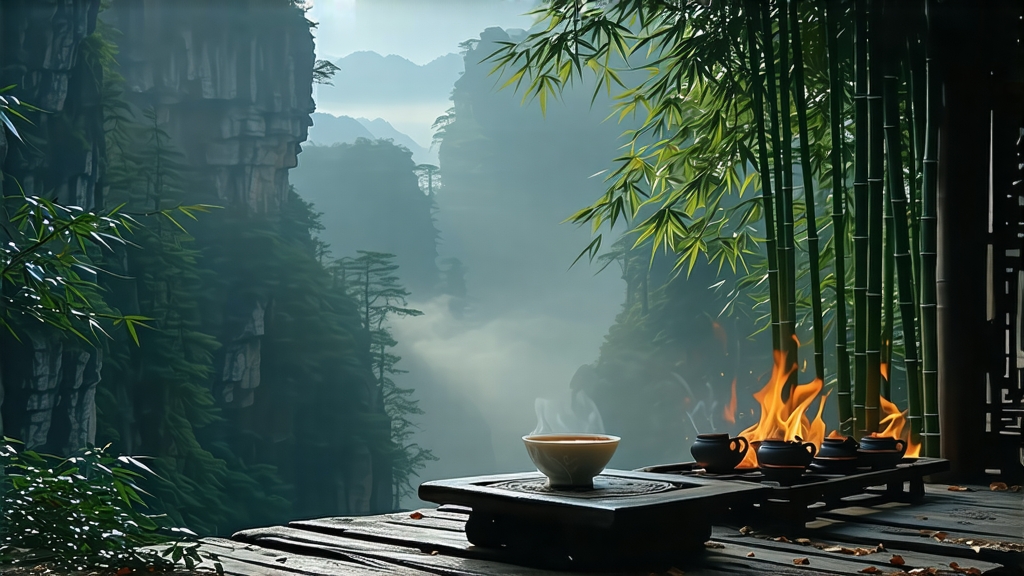
If black tea were a royal court, Lapsang Souchong would be the enigmatic founder who arrived from the wilderness wearing the scent of pine and the mystery of mist. Originating in the Wuyi Mountains of northern Fujian around the mid-seventeenth century, this is the earliest black tea known to the world, the prototype that later inspired Keemun, Assam, Ceylon and every other fully oxidised leaf. Yet unlike its globe-trotting descendants, Lapsang Souchong never shed its mountain soul; it still carries the cool breath of fir and the mineral whisper of volcanic rock in every cup.
The name itself is a miniature map. “Souchong” refers to the fourth and fifth leaves of the tea bush—broader, older and tougher than the prized buds picked for green tea. “Lapsang” is the anglicised form of “Lazheng”, the village that straddles the Tongmu Guan pass, 1,200 m above sea level, where the first batch was allegedly born out of wartime haste. Legend says that in 1646 a Qing army unit was quartered in the Wuyi during the transition from Ming loyalists to Manchu rule. To dry the tea quickly before the soldiers returned, farmers spread the leaves over pine fires; the smoke impregnated the leaf, creating a flavour so startling that Dutch traders in Xiamen paid double the usual price. Whether myth or marketing, the story captures the tea’s dual identity: accident and artefact, frontier ingenuity and export commodity.
Today the European Union recognises Tongmu Guan as a protected designation of origin; only leaf grown inside the 565 km² core zone may bear the name “Zhengshan Xiaozhong” (the Chinese counterpart of Lapsang Souchong). Within that microclimate, two distinct styles survive. The traditional “smoked” version, still produced for Russia and the Middle East, is withered over resinous Masson pine, then pan-fired, rolled, oxidised and finally dried on bamboo trays suspended above slow pinewood embers for up to twelve hours. The resulting leaf is glossy black with golden tips, smelling of campfire, dried longan and a touch of frankincense. The second, newer “unsmoked” or “craft” style, developed in the early 2000s for the delicate palates of coastal China and Japan, omits the final smoking stage; instead the tea is baked over charcoal made from local hardwood, allowing the natural honey, date and malt notes to emerge without the signature pine veil. Both share the same cultivar—Xiao Ye Zhong (Small-Leaf Species), a semi-wild Camellia sinensis var. sinensis that has acclimated to the Wuyi’s short daylight, high humidity and diurnal temperature swings of 15 °C.
Harvest begins in late April, when the mountain azaleas are in bloom and the air smells of wet granite. Pickers climb narrow stone staircases carved during the Song dynasty, filling wicker baskets with one bud and two leaves, the standard that balances sweetness and structure. Withering is done indoors on bamboo screens placed above ground-level channels where pine smoke can drift through if the smoked style is intended. Oxidation is brief—only 70–80 %—because the goal is a reddish-black leaf that will still shimmer with a trace of green when held to the light. The critical moment is the “pine-fire drying”: the tea master, called the shifu, gauges the heat by placing his palm three hand-widths above the embers; when he can hold it for five seconds but not six, the temperature is 90 °C, ideal for fixing the smoke without scorching the leaf. A single lapse and the batch tastes like burnt bacon; a single hour too short and the fragrance is merely superficial, disappearing after the first infusion.
To brew Lapsang Souchong gongfu style, use a small Yixing teapot or a gaiwan of 120 ml. Rinse the vessel with boiling water, then add 5 g of leaf—about two heaping teaspoons. The first infusion, 5 seconds, is discarded; it is the “tea’s handshake”, waking the leaf and rinsing away any surface smoke. The second infusion, 10 seconds, yields a liquor the colour of Château Margaux: clear, bright, with a rim of copper. Lift the cup to